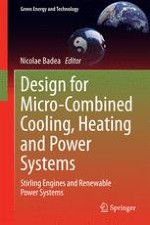2015 | Buch
Über dieses Buch
This book provides a manual for the technical and structural design of systems for supplying decentralised energy in residential buildings. It presents the micro-combined cooling, heating & power systems Stirling engines & renewable energy sources (mCCHP-SE-RES) systems in an accessible manner both for the public at large, and for professionals who conceive, design or commercialise such systems or their components. The high performance levels of these systems are demonstrated within the final chapter by the results of an experiment in which a house is equipped with a mCCHP-SE-RES system. The reader is also familiarized with the conceptual, technical and legal aspects of modern domestic energy systems; the components that constitute these systems; and advanced algorithms for achieving the structural and technical design of such systems.
In residential buildings, satisfying demands of durable development has gradually evolved from necessity to obligation and institutionalisation. Consequently a major paradigm change has appeared in the supply of energy to residential buildings, from the centralised production of energy using fossil fuels to the decentralised production of energy using local renewable sources. Furthermore, on the energy system market, energy micro systems which use renewable energy sources are increasingly commercialised. From among these, the mCCHP-SE-RES systems are particularly striking because they offer a high performance and they enhance the relationship between humans and the environment. This book is intended for postgraduate students of electrical engineering, applied mathematicians, and researchers of modelling and control of complex systems or power system technologies.
Anzeige
